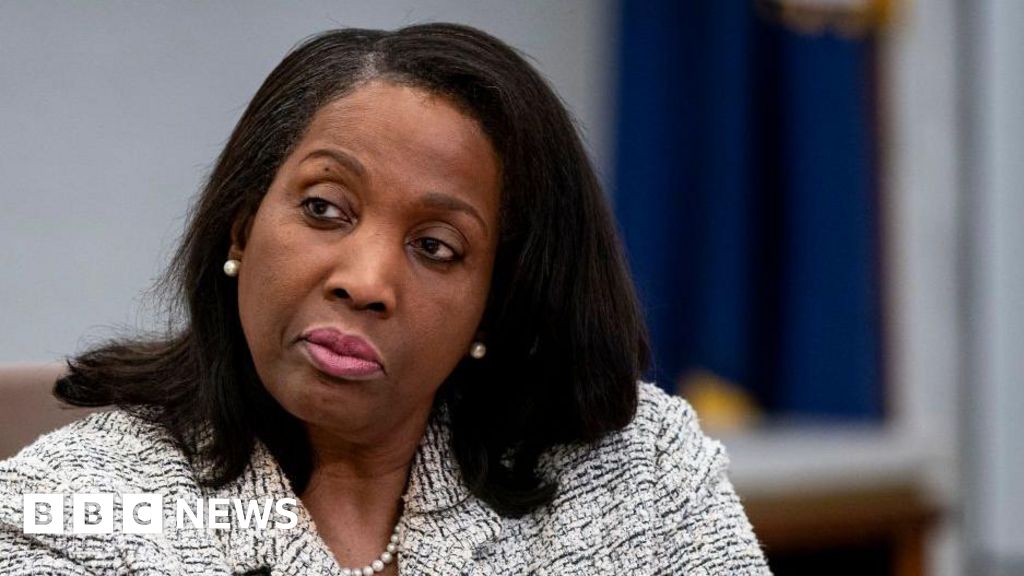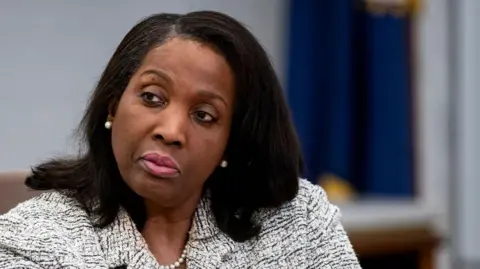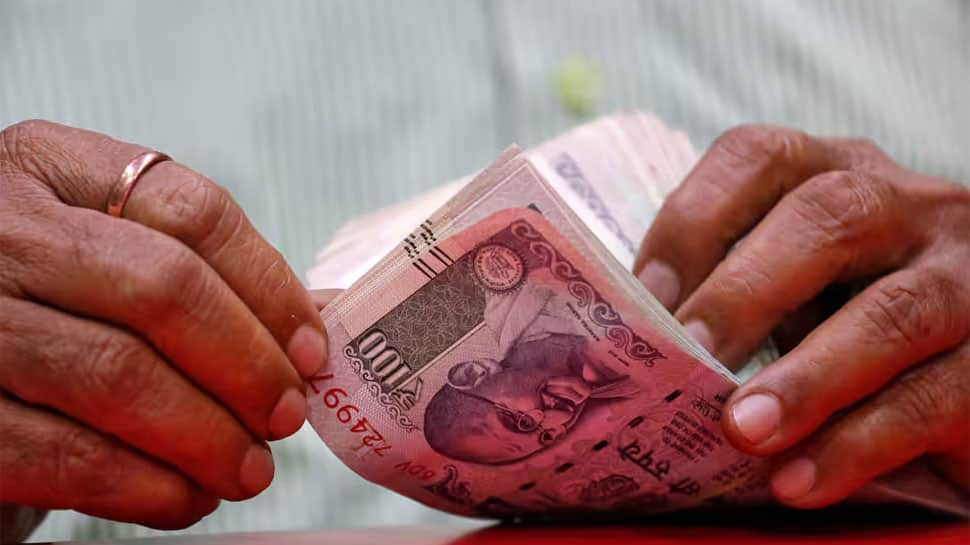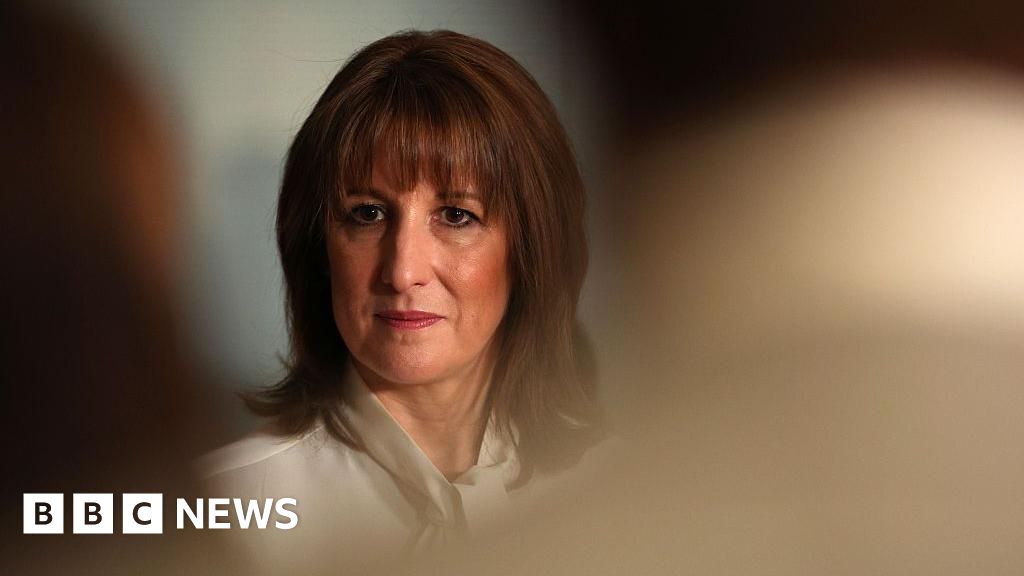Business
Who is Lisa Cook, and what is Federal Reserve governor accused of?

BBC News
 Getty Images
Getty ImagesPresident Donald Trump has demanded the removal of one of the governors of the US central bank, a move that escalates his long-running feud with the institution.
Late on Monday, he posted on his Truth Social account a letter addressed to Lisa Cook, saying she was being removed from the Federal Reserve Board of Governors due to mortgage fraud allegations.
The move has caused an outcry from Democrats who say it amounts to unprecedented political interference.
Who is Lisa Cook and what does she do?
Ms Cook was appointed as governor of the Federal Reserve in 2022 by Democratic President Joe Biden, becoming the first African American to serve in the role. Her term was due to end in 2038.
She previously served on Barack Obama’s Council of Economic Advisers and worked at the US Treasury.
There are seven governors on the board of the Fed and they play a key role in setting the monetary policy of the US.
They make up the majority of the committee that decides the level of US interest rates and aims to keep prices stable and unemployment as low as possible.
Ms Cook has voted in recent months to keep interest rates on hold this year.
What has Trump accused Lisa Cook of?
In his Truth Social post, the president cited allegations that Ms Cook may have falsified records to obtain a mortgage.
He said she signed two documents, two weeks apart, attesting that two homes in different states were both her primary residence.
“It is inconceivable that you were not aware of your first commitment when making the second. It is impossible that you intended to honor both,” he wrote.
CNN has obtained and reviewed the mortgage documents in question and found she did claim two primary residences but it is unclear whether she informed either lender of the fact.
Ms Cook has not been charged with any wrongdoing and in a statement she said she would fight her dismissal because Trump did not have just cause to fire her.
What does the Fed do?
As the central bank of the US, the Federal Reserve is responsible for running the nation’s monetary policy, promoting stability in the financial system, regulating institutions and other tasks.
One of the most visible activities it undertakes is to set interest rates. This has a big impact on the nation’s financial conditions by influencing how much money people can borrow.
The Fed functions as a federal agency and is considered to be independent within government – its decisions do not require the president’s approval, though it is accountable to Congress.
Can Trump actually fire her?
This question could become the subject of an intense legal battle.
The Federal Reserve Act does not give the president license to remove a Fed official at will but, as Trump noted in his letter to Ms Cook, it does allow him to do so “for cause”.
Trump cited a “criminal referral” against Cook – after his ally, the housing finance regulator, recently called for Ms Cook to be investigated for mortgage fraud. But it is not clear whether an investigation has been opened, and Ms Cook has not been charged with any crime.
As well as Ms Cook’s denial that there is any cause to sack her, legal experts have shown scepticism.
Shan Wu, a former federal prosecutor, told CNN: “As of right now, I think it’s kind of questionable for cause, but obviously that’s what [Trump] is relying on, and I would expect her to challenge it.”
Market reaction to Trump’s move has been relatively tame so far – as investors, too, appear to be sceptical and are waiting to see if the sacking actually comes to pass.
Why does Trump want lower interest rates?
Trump has spent much of his second presidency putting pressure on the Fed, demanding that Powell cut interest rates to lower the cost of borrowing for American businesses and consumers. The target range is currently 4.25 to 4.5%.
Central banks typically cut rates in an effort to boost growth. But there is a balancing act, because higher interest rates help to keep inflation in check. Tackling inflation is another Trump priority.
Lower rates can also help US exporters and easing trade deficits is a central plank of Trump’s economic policy.
Powell has so far steadfastly refused to reduce rates since Trump took office, but has hinted at a cut in September.
Business
Pensioners Alert! Govt Asks Banks To Provide Pension Slip To Govt Employees On Monthly Basis

New Delhi: The Department of Pension & Pensioner’s Welfare (DoPPW) under the Ministry of Personnel, PG & Pensions has issued its latest Office Memorandum regarding Pension Payment Slip to all Central Civil Pensioners/Family Pensioners on monthly basis.
In its OM, the DoPPW has asked all banks to adhere to its previous order on issuance of pension slip. DoPPW highlighted that grievances are being still received in this office from Pensioners/Family Pensioners about the non-receipt of Pension Payment Slip.
“All CPPCs of Authorised Banks are once again instructed to invariably provide the pension payment slip to all central civil pensioners and family pensioners after credit of pension/family pension through various available modes including email,” DoPPW said.
The DoPPW further said that if email is not available, the same may be obtained from the pensioner so that the pension slip can be sent through e-mail also.
Business
OBR head’s resignation leaves potential landmines for Reeves

The shock resignation came for a very specific reason, but the OBR saga will continue with a series of decisions the chancellor will have to make over Richard Hughes’ replacement.
Firstly the Chancellor will have to find a respected and credible economist to run the OBR.
There are several candidates, who might fit the mould of fiercely independent bean counters.
The list will be carefully watched by the markets for any departure from the normal model. The problem is that there is some political pressure to do just that.
One of the points of tension was the refusal of Richard Hughes to give credit to the Government for “pro growth” policies.
Mr Hughes had said he would not score any policy unless it was material in its impact on the economy. In the event, none reached the 0.1% of national income threshold.
It is a careful balancing act, however.
Any perceived interference with the OBRs independence could impact market credibility too, and, for example raise UK government borrowing costs.
When I saw the now-departing chairman on the evening of the Budget last week, he was clearly mortified by the responsibility of his organisation for the early release of Budget information.
While it is no surprise to me that Mr Hughes took the honourable decision to resign for an error identified as the fault of a junior member of staff, it was not the only issue vexing him.
He was a fierce defender of the independence of his organisation from political and ministerial pressure – from right and left. That was seen during the Liz Truss mini budget episode, and in recent weeks too.
There had been a drumbeat of noise from the right, and the left and now from the centre too about the restrictions the OBR system placed on the freedoms of elected Governments.
The OBR was in some corners seen as an arm of a “woke deep state”, and by others as an “agent of austerity”.
There had, however, been tension over the Budget.
Changes had already been planned. The Chancellor had also announced that it would only respond to the OBR’s forecasts once a year.
Mr Hughes told me: “We’ll still be producing two full economic and fiscal forecasts looking five years out, twice a year, now and in the spring.
“But with this change of legislation, the government doesn’t feel obliged to respond to those forecasts with policy in the spring. It’ll be more like a health check on the economy and the public finances.
“There’ll be no loss of transparency from the forecast documentation that we’ll produce.”
The precise design of the new approach to the OBR’s forecast will matter. If there is a marked improvement in the public finances in spring, will the chancellor really avoid spending any “surplus” ahead of crucial local elections?
The OBR did around the Budget score an improvement to the UK economy as a deployment of AI by the end of the decade. The OBR also used new powers to initiate a tricky costing for the ballooning cost of special educational needs in England, inviting a backlash from some Cabinet ministers.
For some this underscores its ability like no campaign or Cabinet minister initiative, to focus Government priorities. Hughes denied the 35-member forecasting group was too powerful.
“The powers given to us are those given to us by Parliament in an Act of Parliament, and that’s to produce a forecast. Chancellors set their own targets. They set their own policies. Chancellors are in charge of £1.5 trillion worth of revenue and £1.5 trillion worth of spending.
“If they don’t want to meet their targets, they can change them, which we’ve seen chancellors do in the past as well. All we do is produce a baseline forecast, cost government policies when they give them to us, and we give them an assessment about whether we’re up there, in line and on track to meet those targets,” he told me.
In terms of the Government’s difficulties over the run up to this Budget, Mr Hughes may also take some important details of the timing of various claims around the state of the public finances to his gardening leave.
He had been due to address the Treasury Select Committee this morning, that has now been cancelled. He recognised the publication of his clarification table on Friday of the evolution of the forecasts was unusual.
Over five years at the OBR Richard Hughes faced five chancellors, and his relationship with all of them was designed to help promote UK economic stability.
The new relationship with a different OBR is an opportunity for the Government, but a big risk too.
Business
Eli Lilly cuts cash prices of Zepbound weight loss drug vials on direct-to-consumer site

The Eli Lilly logo appears on the company’s office in San Diego, California, U.S., Nov. 21, 2025.
Mike Blake | Reuters
Eli Lilly on Monday said it is lowering the cash prices of single-dose vials of its blockbuster weight loss drug Zepbound on its direct-to-consumer platform, LillyDirect, building on efforts by the company and the Trump administration to make the medicine more accessible.
The announcement also comes weeks after chief rival Novo Nordisk unveiled additional discounts on the cash prices of its obesity and diabetes drugs.
Starting Monday, cash-paying patients with a valid prescription can get the starting dose of Zepbound vials for as low as $299 per month on LillyDirect, down from a previous price of $349 per month. They can also access the next dose, 5 milligrams, for $399 per month and all other doses for $449 per month, down from $499 per month across those sizes.
Zepbound carries a list price of roughly $1,086 per month. That price point, and spotty insurance coverage for weight loss drugs in the U.S., have been significant barriers to access for some patients.
Eli Lilly’s announcement comes just weeks after President Donald Trump inked deals with Eli Lilly and Novo Nordisk to make their GLP-1 drugs easier for Americans to get and afford. The agreements will cut the prices the government pays for the drugs, introduce Medicare coverage of obesity drugs for the first time for certain patients and offer discounted medicines on the government’s new direct-to-consumer website launching in January, TrumpRx.
But Eli Lilly’s deal with Trump centers around lowering the prices of a different form of Zepbound – a multi-dose pen – after it wins Food and Drug Administration approval.
That means Eli Lilly’s Monday announcement around cutting prices on the existing single-dose vials could allow more patients to get discounted treatments more quickly.
“We will keep working to provide more options — expanding choices for delivery devices and creating new pathways for access — so more people can get the medicines they need,” said Ilya Yuffa, president of Lilly USA and global customer capabilities, in a statement.
Eli Lilly’s stock, which has climbed more than 36% this year, fell nearly 2% on Monday. Its meteoric rise due to the success of Zepbound and its diabetes injection Mounjaro vaulted it to becoming the first health-care company to hit a $1 trillion market value last month. Though cutting prices means lower revenue per medication sold, Eli Lilly’s sales — and shares — have continued to soar through past pricing announcements as demand balloons.
With single-dose vials, patients need to use a syringe and needle to draw up the medicine and inject it into themselves. Eli Lilly first introduced that form of Zepbound in August 2024.
It’s unclear how many patients are currently using single-dose vials of Zepbound. But Eli Lilly previously said that direct-to-consumer sales now account for more than a third of new prescriptions of Zepbound.
Novo Nordisk earlier this month lowered the price of its obesity drug Wegovy and diabetes treatment Ozempic for existing cash-paying patients to $349 per month from $499 per month. That excludes the highest dose of Ozempic.
The company also launched a temporary introductory offer, which will allow new cash-paying patients to access the two lowest doses of Wegovy and Ozempic for $199 per month for the first two months of treatment.
-

 Sports1 week ago
Sports1 week agoWATCH: Ronaldo scores spectacular bicycle kick
-

 Entertainment1 week ago
Entertainment1 week agoWelcome to Derry’ episode 5 delivers shocking twist
-

 Politics1 week ago
Politics1 week agoWashington and Kyiv Stress Any Peace Deal Must Fully Respect Ukraine’s Sovereignty
-

 Business1 week ago
Business1 week agoKey economic data and trends that will shape Rachel Reeves’ Budget
-

 Tech6 days ago
Tech6 days agoWake Up—the Best Black Friday Mattress Sales Are Here
-

 Politics1 week ago
Politics1 week ago53,000 Sikhs vote in Ottawa Khalistan Referendum amid Carney-Modi trade talks scrutiny
-

 Fashion1 week ago
Fashion1 week agoCanada’s Lululemon unveils team Canada kit for Milano Cortina 2026
-

 Tech2 days ago
Tech2 days agoGet Your Steps In From Your Home Office With This Walking Pad—On Sale This Week





